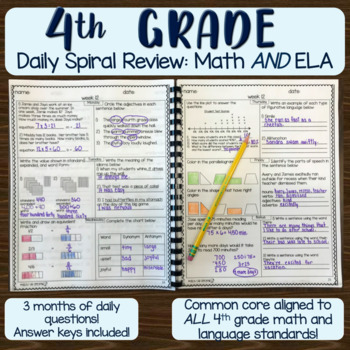4th Grade Daily Spiral Review and Bell Work--12 Weeks!
DesignedbyDani
77 Followers
Grade Levels
3rd - 5th, Homeschool
Subjects
Resource Type
Standards
CCSS4.MD.A.1
CCSS4.MD.A.2
CCSS4.MD.A.3
CCSS4.MD.B.4
CCSS4.MD.C.5
Formats Included
- PDF
Pages
50 pages
DesignedbyDani
77 Followers
What educators are saying
I really liked this resource for my students, it gave them something to work on each morning. I like that hits both math and ela.
I love this packet! Full of great resources that are well constructed, have a nice clean look (not busy looking), and well structured. Thank you! :)
Description
Are you looking for a simple yet effective way for students to practice both math AND ELA skills each day? This ~10 minute daily review makes it easy! It is perfect for morning work or at home review! Simply print double sided for a no-prep self starter book that both you and your students will love!
*Year long (40 week) edition coming soon!
This is a great way for fourth grade students to get grade level practice each day. It can also be used as enrichment for younger students or reteaching for older students!
What is Included:
- 12 weeks of daily review questions
- 3-5 Common Core aligned math questions per day
- 3-5 Common Core aligned ELA questions per day
- Answer key!
Math Skills Covered:
- Multi-digit addition with and without regrouping
- Multi-digit subtraction with and without borrowing
- Basic multiplication and division
- Multi-digit multiplication
- Long division
- Identifying and drawing fractions
- Finding equivalent fractions
- Drawing fractions on a number line
- Identifying and drawing angles
- Identifying and drawing 2 dimensional shapes
- Interpreting data on a line plot or a bar graph
- Rounding and understanding place value
- Solving multi-step word problems
- Interpreting customary and metric units of measurement
- Telling time and elapsed time
- Comparing numbers
- Logic puzzles
ELA Skills Included:
- Punctuation (quotes, commas, and more!)
- Editing sentences for grammar and content
- Identifying parts of speech (nouns, verbs, adjectives, adverbs)
- Common vs. proper nouns
- Multiple meaning words and homophones
- Synonyms and antonyms
- Using academic vocabulary in a sentence
- Verb tenses
- Editing sentence fragments and run- ons
- Commonly misspelled words
- Prefixes, suffixes, and root words
- Contractions
- Idioms and figurative language
Total Pages
50 pages
Answer Key
Included
Teaching Duration
3 months
Report this resource to TPT
Reported resources will be reviewed by our team. Report this resource to let us know if this resource violates TPT’s content guidelines.
Standards
to see state-specific standards (only available in the US).
CCSS4.MD.A.1
Know relative sizes of measurement units within one system of units including km, m, cm; kg, g; lb, oz.; l, ml; hr, min, sec. Within a single system of measurement, express measurements in a larger unit in terms of a smaller unit. Record measurement equivalents in a two-column table. For example, know that 1 ft is 12 times as long as 1 in. Express the length of a 4 ft snake as 48 in. Generate a conversion table for feet and inches listing the number pairs (1, 12), (2, 24), (3, 36),...
CCSS4.MD.A.2
Use the four operations to solve word problems involving distances, intervals of time, liquid volumes, masses of objects, and money, including problems involving simple fractions or decimals, and problems that require expressing measurements given in a larger unit in terms of a smaller unit. Represent measurement quantities using diagrams such as number line diagrams that feature a measurement scale.
CCSS4.MD.A.3
Apply the area and perimeter formulas for rectangles in real world and mathematical problems. For example, find the width of a rectangular room given the area of the flooring and the length, by viewing the area formula as a multiplication equation with an unknown factor.
CCSS4.MD.B.4
Make a line plot to display a data set of measurements in fractions of a unit (1/2, 1/4, 1/8). Solve problems involving addition and subtraction of fractions by using information presented in line plots. For example, from a line plot find and interpret the difference in length between the longest and shortest specimens in an insect collection.
CCSS4.MD.C.5
Recognize angles as geometric shapes that are formed wherever two rays share a common endpoint, and understand concepts of angle measurement:





